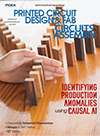News
News
The Great Testing Migration
Published: 03 September 2008
by Terry Munson
As 0201s and 01005s pop up, cleanliness monitoring progresses as well.
The principle behind all automated ROSE testers (Figure 1) that perform to IPC-TM-650 method 2.3.25 is to use the recirculated solution to rinse ionic residues from the board and component surfaces and measure the resistivity change. As this change occurs over the testing time (15 to 60 min.), it reports the amount of ionic residue cumulatively detected from the board surface in the 3-5 gal. testing tank with a 2 gal. solution reserve. Because no standard operating protocol has been developed for determining the ratio of solution to board surface area, it is generally accepted to use the largest tank and volume with a single bare board or assembly to determine ionic residues.

The principle of localized extraction (Figure 2) is to isolate a single area (cell #1 = 0.1 in2 area) and to administer heated extraction solution (18.3 MΩ DI water with less than five TOC level) to the specific area. The extraction has three phases:
Apply heated solution to the spot (this is a microburst of steam).Repeat a total of nine times to solublize and remove the residue in the specific location. Now the solution can be electrically assessed and analyzed by ion chromatography with a small ratio of 0.1 in2 to 2.5 mls of solution.
Allow the solution to soak for at least 5 sec.
Aspirate the solution of the spot surface.
Now the topside repaired part cleanliness can be compared against the cleanliness of the first reflow step, or the cleanliness of a soldered area versus the bare board area.
Using localized extraction to assess the residue, we can see the contamination is from the specific area, and understand the electrical effect of the amount and type of ionic residue. Contamination found in an area of failure also can be compared to other assemblies in the same area that are not failing. This allows us to understand processing variables that impact performance.
Using a Dionex ICS 2000 system to run anion and cation analysis in 17 min., we have great separation for the following ionic and organic residues (Figure 3):
- Anions by AS22 separate fluoride, formate, acetate, MSA, chloride, nitrite, bromide, nitrate, phosphate, sulfate, succinic, malic, maliec, glutaric and adipic acids.
- Cations by CS12a separate sodium, potassium, amine, lithium, calcium and magnesium.

By using the AS22 column of Dionex and modifying the eluent to get great separation, we have solved the co-elution problems from the AS4A-SC and AS18 columns on sulfate and all the WOA, and sulfate from bromide.
By using ROSE testing on a production floor, large changes can be seen and investigated. Periodically we have seen high ROSE readings, but as a general rule, boards pass with good ROSE readings. By looking at localized pockets of contamination on the assembly in critical circuit areas and entrapment locations, we can control a cleaning or selective wave soldering process. It is the pocket of contamination causing leakage and corrosion problems in the field and during ESS testing, so a process controlled with tools designed to look at contamination in different areas provides the best understanding of process and residue effects.
Terry Munson is with Foresite Inc. (residues.com); tm_foresite@residues.com. This column appears monthly.
Press Releases
- NEPCON ASIA 2025: Innovating Smart Manufacturing Ecosystems and Bridging Global Opportunities
- Viasion Technology Expands Global Reach as a Trusted PCB Manufacturer and EMS Provider in China
- Viasion Technology Expands Global Reach as a Trusted PCB Manufacturer and EMS Provider in China
- Nordson Test & Inspection Expands Partnership with Distributor smartTec Nordic A/S







